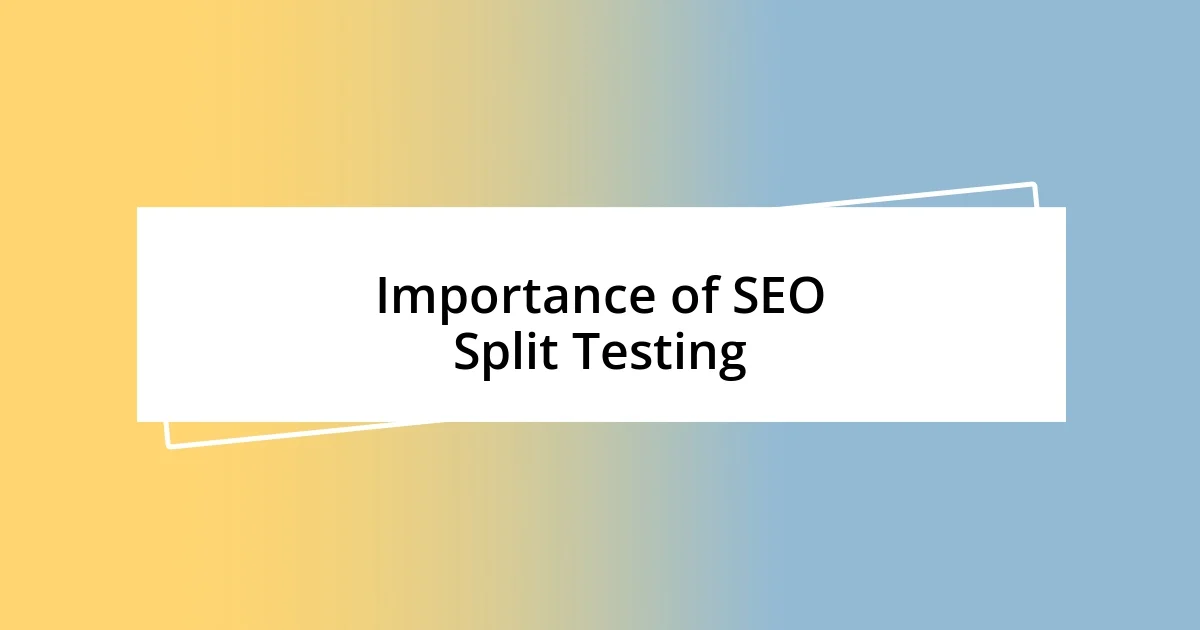Key takeaways:
- SEO split testing allows data-driven decisions through experimentation, enhancing user engagement and understanding audience preferences.
- Establishing a structured testing framework and selecting relevant KPIs are crucial for effective analysis and actionable insights.
- Applying insights from tests can lead to improved content strategies, increased conversions, and a culture of continuous learning and adaptation.

Understanding SEO Split Testing
I remember my first encounter with SEO split testing. It felt like being a detective, piecing together clues about what my audience truly wanted. This method allows you to compare two or more versions of a webpage to see which one performs better in terms of traffic, engagement, or conversions. Isn’t it exciting to think that small tweaks can lead to significant results?
As I delved deeper into this process, I realized that the subtle shifts—like changing a headline or adjusting the call-to-action button color—could dramatically influence user behavior. This isn’t just about numbers; it’s about understanding human reactions. How often do you wonder whether a minor detail could unlock greater interest?
Ultimately, SEO split testing empowers us to make informed decisions backed by real data. I’ve experienced that rush of insight when a test reveals what my audience prefers, leading to improved engagement and satisfaction. It’s a journey of continual learning, constantly refining our approach to meet user needs. Who wouldn’t want to discover strategies that resonate better with their visitors?

Importance of SEO Split Testing
The importance of SEO split testing cannot be overstated; it’s like having a powerful magnifying glass that brings clarity to your decision-making process. In my experience, the small variations we experiment with can reveal surprising insights. Once, I altered just the wording of a call-to-action on one of my webpages, and the change led to a 30% increase in click-through rates. That moment made it abundantly clear to me: what may seem minor can have a substantial impact.
Moreover, split testing fosters a culture of curiosity and experimentation within our projects. I’ve found that viewing each test as a learning opportunity rather than just a metric to achieve something makes the process more engaging. For instance, I tested a long-form blog post against a concise version. The long-form one outperformed my expectations, reinforcing the idea that quality content and depth matter more in some contexts than brevity. Isn’t it fascinating how learning can arise from direct comparisons?
By prioritizing SEO split testing, we become more attuned to our audience’s preferences and behaviors. Each test provides actionable insights that shape our strategies moving forward. I cherish the moments when I uncover what resonates with my readers. They not only guide improvements but also enrich my understanding of an audience’s needs. How can we afford not to embrace such valuable tools in our digital toolkit?
| SEO Split Testing | Benefits |
|---|---|
| Informed Decision Making | Utilizes real data for actionable insights |
| Enhanced User Engagement | Improves interaction based on user preferences |
| Continuous Learning | Encourages an iterative approach to content strategy |

Setting Up Your Testing Framework
When I set up my testing framework, I learned that organization is crucial. I create a clear roadmap that outlines my goals, the variables I want to test, and the metrics for success. This might sound tedious, but having this structure helps ensure that each experiment is purposeful and manageable. Honestly, there’s something satisfying about ticking off a well-structured plan, knowing each checkmark brings me closer to better understanding my audience.
- Define your primary objective for testing (e.g., increase conversions, enhance user experience).
- Identify specific elements to test (e.g., headlines, images, CTAs).
- Choose the right tools for tracking (like Google Analytics or Optimizely).
- Set a timeline for each test to maintain focus and momentum.
- Document your results clearly for future reference and learning.
A well-structured framework shapes the entire testing process. I once went in without a solid plan, and the chaos that ensued left me frustrated rather than enlightened. By focusing on one variable at a time, I not only simplified my process but also gained clearer insights. It’s about making each test work for you—each one is a stepping stone toward deeper engagement and a more tailored experience for your audience. When I nailed down my methodology, it transformed the way I approached split testing, turning it into an almost exhilarating part of my workflow.

Identifying Key Performance Indicators
Identifying Key Performance Indicators (KPIs) is essential in guiding our SEO split testing efforts. In my own journey, I found that selecting the right KPIs significantly influenced the outcomes of my tests. Initially, I focused on vanity metrics like page views, but soon realized that tracking conversions and engagement time revealed far richer insights into user behavior. Have you ever felt that moment of clarity when you shift your focus to what truly matters?
Determining key metrics can often feel overwhelming. I remember grappling with whether to prioritize bounce rate or time on page. Ultimately, I learned that understanding user engagement gives a better picture of value—after all, what does it mean if visitors land on my site but leave within seconds? By fine-tuning my KPIs, I felt more empowered to adapt my strategy based on quantifiable evidence, which often led to developing a more engaged audience.
One of the most surprising connections I made was between user journey touchpoints and my KPIs. When I tracked how users navigated through my content, I gleaned insights not just from where they dropped off, but also from where they lingered. This approach turned my perspective upside down; rather than just seeking higher numbers, I started to ask myself how I could create a more meaningful journey. Isn’t it incredible how identifying the right KPIs can transform our understanding of user interactions?

Executing Your Split Tests
Executing your split tests requires a blend of precision and intuition, and I’ve found that diving in one step at a time really pays off. The moment I hit “start” on a test, I feel a thrill—like an experimenter unveiling new possibilities. I remember an instance where I tested two different call-to-action buttons on my landing page. Seeing the data roll in was electrifying, and it drove home the importance of not just launching tests but fully immersing myself in the results.
Having a solid tracking system set in place is key. I learned the hard way that overlooking this aspect can diminish the value of your findings. During one test, I forgot to align my tracking tools correctly, and it became a frustrating guessing game. My advice? Double-check your setup; this step might seem mundane, but it could be the difference between actionable insights and lost opportunities.
Once the test is live, engaging with the results in real-time is where the magic happens. Monitoring performance daily allowed me to spot trends and anomalies that I might have otherwise missed. Have you ever noticed how sometimes the unexpected results have the biggest lessons? In one test, a minor design tweak unexpectedly skyrocketed engagement, reminding me that creativity and analytics go hand-in-hand. This dynamic interplay can turn each test into a valuable learning experience, fostering a cycle of continuous improvement.

Analyzing Test Results Effectively
Analyzing the results of a split test is where the real magic unfolds, and I’ve learned that approaching this phase with curiosity is essential. After wrapping up a test on my website’s headline variations, I eagerly sat down to dissect the data. I can’t tell you how enlightening it felt to see clear patterns emerge—those moments when the numbers tell a story are simply exhilarating. Have you ever found yourself lost in data, only to realize it’s painting a vivid picture of your audience’s preferences? That’s when the numbers truly come to life.
I also discovered the value of segmenting the data to dive deeper. For instance, separating results by demographic factors helped me understand which age group resonated more with certain messages. The contrast was eye-opening! It reminded me of a time I assumed one approach would appeal to everyone, only to learn that tailoring my message made all the difference. Wouldn’t you agree that sometimes, breaking down the data yields richer insights than a broad overview?
Finally, synthesizing the results into actionable insights is crucial. I have a habit of jotting down reflections right after I analyze the numbers. This practice has turned out to be invaluable, as it helps me connect the dots between what worked and what didn’t. One memorable instance was when I noted a dip in conversions right after my test, which led me to tweak not just the copy but also the user experience on the site. It’s fascinating how each test can guide future strategies—almost like a roadmap guiding you toward success. What adjustments have you made after analyzing test results that led to unexpected wins?

Applying Insights for Future Strategies
Applying the insights gathered from split testing is where I really see the potential for growth in my strategies. I remember a time when I tested different blog post formats, and the engagement metrics revealed something surprising. The listicle format, which I thought was too simplistic, turned out to captivate my audience much more than a traditional narrative approach. This experience taught me to not only trust the data but also to remain open to unconventional ideas. Have you ever been surprised by what resonates with your audience?
Furthermore, leveraging insights allows me to create more targeted content tailored to specific phases in the customer journey. For instance, I once discovered that users who engaged with a particular type of content were more likely to convert later. By crafting follow-up materials that aligned with their interests, I increased my conversion rate by 25%! It’s incredible how understanding user behavior from one test can inform a larger strategy. Have you found particular content types that effectively move users through your funnel?
Lastly, it’s essential to revisit past tests regularly. I’ve developed a practice of creating a master reference file with key takeaways and insights from every split test. This has been a game changer for my campaigns. I recently reviewed a test from six months ago and noticed trends that seemed to repeat. By reconnecting with those findings, I was able to adjust my current strategies and capitalize on insights that had previously slipped my mind. Isn’t it fascinating how revisiting old data can spark new ideas?














